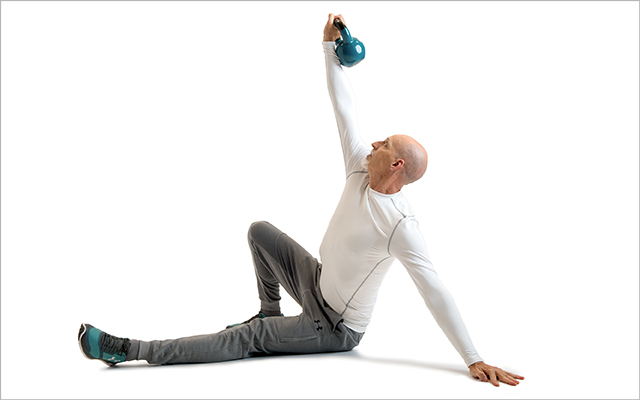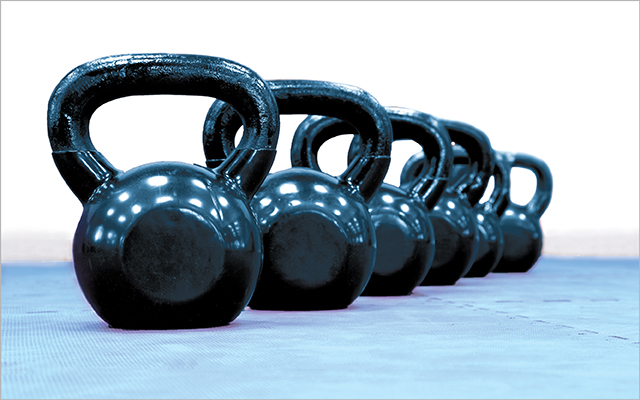The small yet mighty kettlebell is an all-around training tool, and you can take advantage of its inherent versatility simply by varying weights, reps, sets, rest periods, or tempo. Consider this a choose-your-own-intensity workout.
The kettlebell is designed to be dynamic, “giving you everything you need” in one piece of equipment, says Karen Smith, a Master StrongFirst kettlebell instructor. Thanks to its sturdy handle and round shape, it’s ideal for traditional strength-building exercises like presses and rows. But it’s great for ballistic moves, like swings, cleans, and snatches, that quickly bring on a cardio effect to burn fat and build endurance. Few exercise implements offer such wide-ranging benefits.
In general, lifting a heavy weight for fewer reps builds muscles, while using a lighter weight for higher rep counts burns fat. The heavier you lift, the longer you’ll need to recover between sets. If you’re going lighter, you’ll want to take shorter breaks so you maintain a steady heart rate.
To see what this looks like, consider the kettlebell swing: If you use a lighter weight for a higher number of reps and keep your rest periods brief, you’ll work your aerobic capacity. “Think of that as more like a marathon,” Smith explains.
But if you swing a heavier weight for fewer reps and take a longer break, you’ll build muscular power and strength. “I think of those as more like sprints,” she says.
These two full-body workouts, designed by Smith, use the same exercises and equipment — but they are hardly identical, thanks to variations in the rep counts and rest times. Take your pick.
Workout Overview
For either workout, choose a weight that you find challenging when performing the prescribed number of reps. The weight for the moves in the strength-building routine should be heavier than in the fat-burning one.
Need another way to determine weight selection? You should be able to complete the prescribed number of reps, be ready to rest when it’s time to rest, and then be ready to move again once the rest period is over.
If you find that you can easily perform more than the prescribed reps or don’t need to rest, increase the weight. If you are unable to complete the reps or can’t recover within the prescribed rest period, decrease the weight.
- For strength building, plan to rest for double the amount of time it takes to complete a set.
- For fat-burning, work twice as long as you rest. So, if it takes you one minute to complete a set, rest for 30 seconds.
The Workouts
Strength-BuildingPerform this low-rep, long-rest routine up to 3x per week. |
Fat-BurningPerform this high-rep, short-rest routine up to 5x per week. |
||
| 1. Half Get-Up | 1 rep per side | 1. Half Get-Up | 3 sets of 3 reps per side |
| Rest: 2-3 minutes; repeat 3x | Rest: 30-90 seconds between each set | ||
| 2a. Goblet Squat | 5 reps | 2a. Goblet Squat | 10 reps |
| 2b. One-Arm Overhead Press | 5 reps per side | 2b. One-Arm Overhead Press | 8-10 reps per side |
| Rest: 3-5 minutes between supersets, completing 3 rounds |
Rest: 30-90 seconds between supersets, completing 3 rounds total |
||
| 3a. One-Arm Suitcase Deadlift | 5 reps per side | 3a. One-Arm Suitcase Deadlift | 8-10 reps per side |
| 3b. One-Arm Floor Press | 5 reps per side | 3b. One-Arm Floor Press | 8-10 reps per side |
| Rest: 3-5 minutes between supersets, completing 3 rounds total |
Rest: 30-90 seconds between supersets, completing 3 rounds total |
||
| 4. Two-Handed Swing | 5 sets of 10 reps | 4. Two-Handed Swing | 10 sets of as many good-form reps as possible in 1-minute |
| Rest: 3-5 minutes between each set | Rest: 30 seconds between each set | ||
Half Get-Up
This full-body move fires up your core, shoulders, hips, and glutes while improving flexibility and mobility.
- Lie face-up on the floor with a kettlebell at your right side. Roll to the side to spoon the kettlebell, and grab the handle with your right hand. With the kettlebell tight against your chest, roll to your back while keeping your right knee bent.
- Press the kettlebell straight up over your chest. Place your nonworking left arm and leg on the ground at about a 45-degree angle from your body.
- Leading with the chest, press into the floor with your planted foot and nonworking arm until you’re propped up on your left elbow. Extend your left arm until it’s straight and you’re sitting tall. Pause, then lower back to the starting position. Keep your eyes on the kettlebell throughout the movement.
- Complete all repetitions on one side before switching to the other. (For additional tips and how to perform the full Turkish Get-Up, see “3 Ways to Improve Your Turkish Get-Up“.)
Make it easier: Perform the movement without added weight.
Goblet Squat
Engages the core, quads, and upper back. Unlike some other squat variations, this one is gentler on your lower back.
- Standing with feet hip width apart and holding a kettlebell at your chest, push your butt back and bend at the knees to lower into a squat. Keep your torso upright and knees in line with your toes throughout the movement.
- Drive through your heels to push back to standing.
Make it easier: Perform the movement without added weight.
One-Arm Suitcase Deadlift
Targets the hamstrings as well as commonly overlooked muscles like the obliques and the gluteus medius.
- Place a kettlebell next to the outside of one foot. Stand upright with feet shoulder width apart.
- Without twisting your torso, push your butt back and hinge forward at the hips to grasp the handle of the kettlebell.
- Stand up with the weight and squeeze your glutes at the top. Return the weight to the starting position.
- Complete all reps on one side before switching to the other.
One-Arm Overhead Press
Strengthens the shoulders and challenges core stability as you work to keep your torso from wavering under weight.
- Hold a kettlebell in your right hand at shoulder height so the kettlebell rests against your forearm. Keep your wrist straight and elbow close to your body.
- Brace your core and press the kettlebell overhead without letting your elbow flare out to the side. Pause, then lower the weight to the starting position with control.
- Complete all reps on one side before switching arms.
One-Arm Floor Press
Hits your chest, triceps, and shoulders.
- Lie on the floor with a kettlebell parked beside your left shoulder. Roll to your left side, and grasp the handle with your left hand. Roll back to face up with knees bent and feet firmly planted.
- Keeping your wrist straight and elbow pointing roughly 45 degrees out from your body, press the kettlebell straight up over your chest. Then lower the weight with control until your triceps makes contact with the floor.
- Complete all reps on one side before switching arms.
Two-Handed Swing
This ballistic move works your glutes, hamstrings, quads, shoulders, forearms, and core.
- Set a kettlebell on the floor about a foot in front of you. Lower into a quarter-squat position and grip the kettlebell with both hands.
- Keeping your back straight and shoulders down, hike the kettlebell back and up between your legs. When the kettlebell can’t go any farther, squeeze your glutes and forcefully extend your hips to propel the kettlebell upward, keeping your arms straight throughout.
- When the kettlebell reaches about shoulder height, pull it back down between your legs. Keep your chest high at all times. (For additional tips, see “BREAK IT DOWN: The Kettlebell Swing“.)
(Maximize your kettlebell workout by trying this kettlebell finisher.)




This Post Has 0 Comments